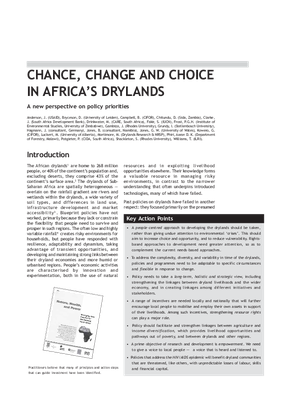CHANCE, CHANGE AND CHOICE IN AFRICA’S DRYLANDS
The African drylands1 are home to 268 million people, or 40% of the continent’s population and, excluding deserts, they comprise 43% of the continent’s surface area.2 The drylands of Sub- Saharan Africa are spatially heterogeneous — overlain on the rainfall gradient are rivers and wetlands within the drylands, a wide variety of soil types, and differences in land use, infrastructure development and market accessibility3 . Blueprint policies have not worked, primarily because they lack or constrain the flexibility that people need to survive and prosper in such regions. The often low and highly variable rainfall4 creates risky environments for households, but people have responded with resilience, adaptability and dynamism, taking advantage of transient opportunities, and developing and maintaining strong links between their dryland economies and more humid or urbanised regions. People’s economic activities are characterised by innovation and experimentation, both in the use of natural resources and in exploiting livelihood opportunities elsewhere. Their knowledge forms a valuable resource in managing risky environments, in contrast to the narrower understanding that often underpins introduced technologies, many of which have failed. Past policies on drylands have failed in another respect: they focused primarily on the presumed
https://biodiversitylinks.org/projects/completed-projects/cbnrm/cbnrm-literature-review-sources/chance-change-and-choice-in-africa2019s-drylands/view
https://biodiversitylinks.org/projects/completed-projects/cbnrm/cbnrm-literature-review-sources/chance-change-and-choice-in-africa2019s-drylands/@@download/image/image.png
File
CHANCE, CHANGE AND CHOICE IN AFRICA’S DRYLANDS
Author(s):
Anderson, J.,
Bryceson, D.,
Campbell, B.,
Chitundu, D.,
Clarke, J.,
Drinkwater, M.,
Fakir, S.,
Frost, P.G.H.,
Gambiza, J.,
Grundy, I.,
Hagmann, J.,
Jones, B.,
Jones, G. W.,
Kowero, G.,
Luckert, M.,
Mortimore, M.,
Phiri, Aaron D. K.,
Potgieter, P.,
Shackleton, S.,
Williams, T.
DOWNLOAD FILE
The African drylands1 are home to 268 million people, or 40% of the continent’s population and, excluding deserts, they comprise 43% of the continent’s surface area.2 The drylands of Sub- Saharan Africa are spatially heterogeneous — overlain on the rainfall gradient are rivers and wetlands within the drylands, a wide variety of soil types, and differences in land use, infrastructure development and market accessibility3 . Blueprint policies have not worked, primarily because they lack or constrain the flexibility that people need to survive and prosper in such regions. The often low and highly variable rainfall4 creates risky environments for households, but people have responded with resilience, adaptability and dynamism, taking advantage of transient opportunities, and developing and maintaining strong links between their dryland economies and more humid or urbanised regions. People’s economic activities are characterised by innovation and experimentation, both in the use of natural resources and in exploiting livelihood opportunities elsewhere. Their knowledge forms a valuable resource in managing risky environments, in contrast to the narrower understanding that often underpins introduced technologies, many of which have failed. Past policies on drylands have failed in another respect: they focused primarily on the presumed



